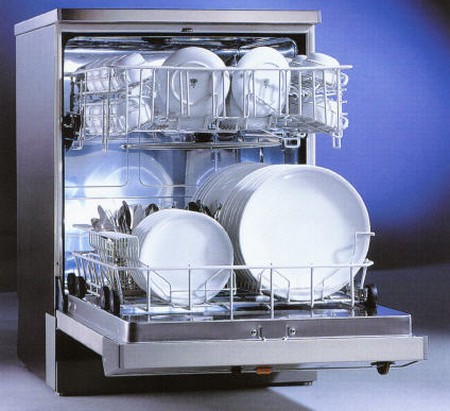Old dishwashers often get rusted areas inside, especially on the dish racks. Or sometimes they just look old-fashioned. (The newer models are largely digital and look quite elegant in all whites or colors with little chrome trim.) When you do any kind of kitchen renovation such as cabinets, counters, or sinks, replace the dishwasher. It’s not that expensive and a new unit can make a big difference to the overall appearance of your kitchen.
If you want to save the old dishwasher for some reason and the rust and deteriorated areas are just on the racks, try to get new racks. These are available for the more common models. It can be a quick-and-easy solution.

The cost of dishwashers varies enormously. You may be able to purchase a low-end Whirlpool or GE model for $250 or less on sale. On the high end, you could end up spending close to $1000 for an elegant model from the same manufacturer. Other manufacturers offer stainless-steel drum tubs for even more money.
It takes virtually no skill to install a dishwasher. You have to watch out for a few things, however. Be sure you have adequate room under the counter. The unit fits right under the countertop and usually attaches to the countertop with just two screws. In older units there may be additional screws holding the washer to the floor. Newer models have feet that adjust up an inch or so to help fitting.
Be wary of removing an old dishwasher if a new floor has been recently put into the kitchen. The new floor may be higher than the old floor on which the washer sits. You may find the old machine impossible to remove without breaking the countertop. If you’re installing a new floor, be sure to shim up the dishwasher so that it’s level with the new floor and, later on, can be removed.
Once the dishwasher is in, you may find that you need to install a tee in the hot water pipe and a shutoff valve in order to supply water to the unit. The dishwasher needs only hot water, not cold. Also, you may need to install an electric outlet under the sink, if one isn’t already there.
Be sure that you always include an overflow “air gap,” required by the building code. This is a device that comes up through a hole in the sink, screws on, and then is capped. Wastewater comes up from the dishwater to the air gap (preventing backflow) and then down into the garbage disposal. Should the disposal be plugged, the wastewater will come out the air gap and flow harmlessly into the sink.
You will need to get a permit and have your dishwasher inspected. Almost all building departments require inspection to be sure that the air gap is properly installed.
Be sure the unit is level so that it doesn’t vibrate when turned on. Be sure all pipe fittings are tight so water leaks don’t develop over time. Since the plumbing is under the sink, leaks might go undetected for quite a while, damaging or warping your cabinets.